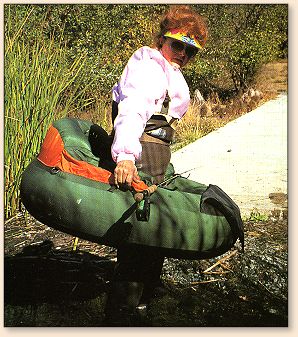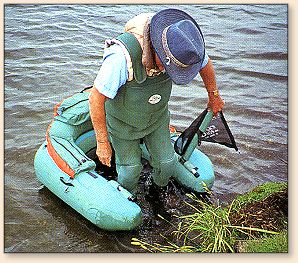|
Your most important piece of equipment is the
tube that you use to get where you want to fish.
There are now three basic types of tubes for you
to consider: round, U-shaped and power.
 First, the traditional round tube ($150-200) comes with
back rest (which is usually an encased smaller,
folded up inflated inner tube), mesh seat, quick
release buckle, pockets, O-rings and velcro for
attaching and securing equipment, a full front mesh
stripping apron that stores retrieved fly line and
lets water pass through. The float tube should be
big enough to fit your body comfortably and yet
give support to your back and legs while providing
a fairly high ride on the water's surface. Another
version of the round tube is a bladder tube which
is a light weight water proof ring ($150-200) without
inner tubes. It can be inflated by mouth and is ideal
for back packing and fishing small lakes or ponds.
First, the traditional round tube ($150-200) comes with
back rest (which is usually an encased smaller,
folded up inflated inner tube), mesh seat, quick
release buckle, pockets, O-rings and velcro for
attaching and securing equipment, a full front mesh
stripping apron that stores retrieved fly line and
lets water pass through. The float tube should be
big enough to fit your body comfortably and yet
give support to your back and legs while providing
a fairly high ride on the water's surface. Another
version of the round tube is a bladder tube which
is a light weight water proof ring ($150-200) without
inner tubes. It can be inflated by mouth and is ideal
for back packing and fishing small lakes or ponds.
 The newer, more expensive U-shaped rube ($275) has
all the features as described above. However it
has an open front-end construction which allows
more maneuverability and is easier to get in and
out of. This tube is particularly useful for the
physically challenged fisherman.
The newer, more expensive U-shaped rube ($275) has
all the features as described above. However it
has an open front-end construction which allows
more maneuverability and is easier to get in and
out of. This tube is particularly useful for the
physically challenged fisherman.
The motor assisted tube (POW-R Tube $550) has the
essential features of the round tube. In addition,
it has an electrical connection to a smaller tube
which is zipped into the basic tube. This tube
holds a 12 volt 10 amp marine battery and a small
trolling motor which extends below the water line.
The smaller tube is easily zipped into the covering
of the larger tube. It has a hand operated
forward/reverse and speed control mounted on the
left/front side of the main tube. Although the
motor assisted tube is more expansive than the
other types, it is much less expensive than a boat
and more easily carried. The motor assisted tube
allows the fly fisher to cover more water with less
fatigue, fish more effectively in the wind and come
back to the launching site safely and easily even
against strong winds...

Usually tubes are not inflated at the time of purchase,
so before taking off for a lake you need to make sure
that your tubes (large and auxiliary in back rest)
are inflated sufficiently to support your weight, but
not enough to overstretch the seams of the fabric
cover. Most gasoline service stations have compressed
air and will offer this service to you. It is also
a good idea to carry a portable pump and deflating
tool in your car to increase or decrease the amount
of air pressure due to changes in temperature or
altitude. Never leave a fully inflated tube in a
hot vehicle because it could explode with increased
air pressure. If you need to leave it in your vehicle,
release some air to prevent damage to your tube. Foot
pumps are available for around $24 and air pumps that
work from your automobile cigarette lighter range from
$30-50.
Fins
Hard rubber or plastic fins are used by float tubers
to propel themselves through the water. There are
many types of fins ($30-100) used for float tube
fishing. The properties to look for are those that
provide you with comfort and effectiveness. You
need a fin that fits comfortably over your wader
boot, sock or bootie and large enough that it does
not cramp your feet and is of a weight suitable to
your own size and strength. Secondly, you need a
fin that will be large and shaped in such a way as
to give you maximum propulsion for each stroke. A
popular fin made by Force Fin ($70-100) has a curved
flexible "V" shape that is extremely efficient,
adjustable for foot and boot size and lightweight.
Its upturned tips allows you to walk forward which
is quite an advantage. Whatever type of fins you
use, even if they are billed as floating, you will
also need a pair of fin tethers ($7). These are
usually nylon or rubber straps that fasten around
your ankle and connect to the fins to prevent loss.
It is very difficult to return to shore or even
continue fishing if you lose one fin! ~ PCP
Continued next time.
Credits: Excerpt from Float Tube
Magic By Patricia C. Potheir, published
by Frank Amato Publications. We appreciate use
permission.
|



 First, the traditional round tube ($150-200) comes with
back rest (which is usually an encased smaller,
folded up inflated inner tube), mesh seat, quick
release buckle, pockets, O-rings and velcro for
attaching and securing equipment, a full front mesh
stripping apron that stores retrieved fly line and
lets water pass through. The float tube should be
big enough to fit your body comfortably and yet
give support to your back and legs while providing
a fairly high ride on the water's surface. Another
version of the round tube is a bladder tube which
is a light weight water proof ring ($150-200) without
inner tubes. It can be inflated by mouth and is ideal
for back packing and fishing small lakes or ponds.
First, the traditional round tube ($150-200) comes with
back rest (which is usually an encased smaller,
folded up inflated inner tube), mesh seat, quick
release buckle, pockets, O-rings and velcro for
attaching and securing equipment, a full front mesh
stripping apron that stores retrieved fly line and
lets water pass through. The float tube should be
big enough to fit your body comfortably and yet
give support to your back and legs while providing
a fairly high ride on the water's surface. Another
version of the round tube is a bladder tube which
is a light weight water proof ring ($150-200) without
inner tubes. It can be inflated by mouth and is ideal
for back packing and fishing small lakes or ponds. The newer, more expensive U-shaped rube ($275) has
all the features as described above. However it
has an open front-end construction which allows
more maneuverability and is easier to get in and
out of. This tube is particularly useful for the
physically challenged fisherman.
The newer, more expensive U-shaped rube ($275) has
all the features as described above. However it
has an open front-end construction which allows
more maneuverability and is easier to get in and
out of. This tube is particularly useful for the
physically challenged fisherman.